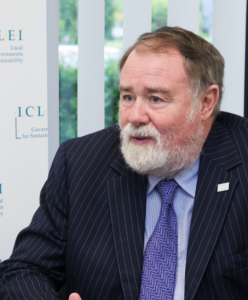
Photo: COP19
A last minute climate compromise
25 November 2013
by Richard Forster
Governments around the world meeting at the Warsaw climate change conference this month reached a partial deal after marathon overnight talks finally wound up in the early hours of Sunday 24 November. It was the first meeting of the parties at which cities were formally invited to participate.
The United Nations Framework Convention on Climate Change (UNFCCC) negotiations were marked by discord and acrimony, and by the emergence of a new negotiating bloc among developing countries.
“We have seen essential progress,” said Christiana Figueres, the UNFCCC Executive Secretary. “But let us again be clear that we are witnessing ever more frequent, extreme weather events, and the poor and vulnerable are already paying the price.”
The talks were made all the more urgent in the light of the devastation of Typhoon Haiyan in the Philippines which claimed many thousands of lives and affected 13.25 million survivors, just as the UNFCCC meeting started.
The deal comes one year ahead of the 2014 Climate Summit in New York.
“Now governments, and especially developed nations, must go back to do their homework so they can put their plans on the table ahead of the (2015) Paris conference,” Figueres added.
For the first time, the talks, which are also known as the Conference of the Parties or COP19, included a special ‘Cities Day of the High Level Segment’.
Officials said all parties now understand that global climate change has become a leading international development issue at the same time as the world has become urbanised. The way we plan, manage, operate and consume energy in our cities will have a critical role in our quest to reverse climate change and its impact.
Seventy-five percent of commercial energy is consumed in urban and peri-urban areas. In addition, 80 percent of all waste is generated from cities, and up to 60 percent of greenhouse gas emissions which cause global climate change emanate from cities, according to UN-Habitat research.
More extreme weather patterns such as Typhoon Haiyan are another. The world is also experiencing more frequent flooding and drought in the same year, causing heavy impact on food security, energy and water supply.
If sea levels rise by just one metre, many major coastal cities will be under threat: Buenos Aires, Rio de Janeiro, Los Angeles, New York, Lagos, Alexandria-Cairo, Mumbai, Kolkata, Dhaka, Shanghai, Osaka-Kobe and Tokyo, just to cite some mega cities that are under imminent threat.
The many smaller coastal cities, especially those in developing countries and those of small island nations will suffer most due to their limited adaptation options. More and more people are drawn to the urban magnet. In many parts of the world, climate refugees from rural areas that have been hit by drought or flooding aggravate the migration to cities.
Thus UN Secretary-General Ban Ki-moon told the high-level meeting on cities: “Cities are engines of dynamism and creativity. In many respects, cities are the proving ground for our efforts to combat climate change, build resilience and achieve faster, more equitable development progress.”
Negotiators also made progress on the contentious issue of loss and damage that developing countries are expected to suffer in a warming world. Environmental groups were angry about the lack of specific commitments on finance.
UN-Habitat Deputy Executive Director Aisa Kirabo Kacyira told the high-level group on cities that local authorities were ready to act on climate change but needed strong frameworks within which to work and budgets to achieve their goals. Dr Kacyira, the former Mayor of Kigali, Rwanda, called for “establishing mechanisms to give qualified local authorities more direct access to international sources of climate finance”.
Speakers at the session included Figueres, and David Cadman, President of ICLEI Local Governments for Sustainability (ICLEI).

“Half of the world’s population lives in cities and by the end of the century, ninety percent will, and we are going to build more in the next 40 years than we’ve built in all of humanity,” Cadman said. “So if we don’t build it right, then it’s going to be a draw on energy, and the form of energy will probably be a dirty one.”
Around 12,000 cities and towns had already joined ICLEI’s network and decided to take concrete action on mitigation, adaptation, urban biodiversity, ecological purchasing and eco-mobility.
“When everyone said it was very difficult to have a greenhouse gas reduction plan, we put it in place,” he said. “And we’ve got a software that cities can now use to measure greenhouse gases and we are seeing really dramatic drops: in 107 municipalities they’re exceeding one percent lowering of greenhouse gases per year.”











